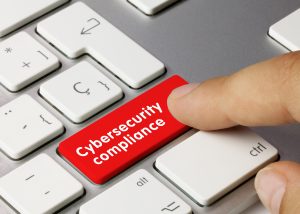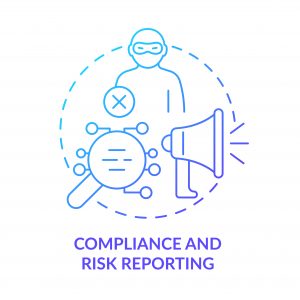Editor's Note: Take a look at our featured best practice, Digital Transformation Strategy (145-slide PowerPoint presentation). Digital Transformation is being embraced by organizations across most industries, as the role of technology shifts from being a business enabler to a business driver. This has only been accelerated by the COVID-19 global pandemic. Thus, to remain competitive and outcompete in today's fast paced, [read more]
Enterprise Cybersecurity Compliance: A Brief Guide
Also, if you are interested in becoming an expert on Digital Transformation, take a look at Flevy's Digital Transformation Frameworks offering here. This is a curated collection of best practice frameworks based on the thought leadership of leading consulting firms, academics, and recognized subject matter experts. By learning and applying these concepts, you can you stay ahead of the curve. Full details here.
* * * *

However, you must follow the set guidelines and regulations when safeguarding and protecting your data against cyber threats. Cybersecurity compliance isn’t easy, especially when you don’t equip yourself with the necessary know-how. The regulations constantly evolve, making it hard for enterprises to keep up. Failure to comply may expose your sensitive data, which may affect your competitive advantage and lead to fines and convictions in case of lawsuits.
The following article gives a quick rundown of what you need to know about cybersecurity compliance. You’ll learn what cybersecurity compliance is, its goals, and how you can comply with the set standards and regulations. Keep reading.
What Does Cybersecurity Compliance Mean?
Every sector has guidelines and regulations which every business under its umbrella must follow when managing its operation, and cybersecurity is no different. Cybersecurity compliance refers to a process of risk assessment that ensures your organization follows the set rules and regulations when handling, storing, processing, and distributing sensitive data. In addition, businesses often implement safeguarding measures and protocols depending on the security management system, which complies with the set standards.
Although it has become necessary for organizations to implement cybersecurity compliance, some still find it challenging to become regulatory compliant. However, employing cybersecurity services in Chicago or your locality can help your risk management process. Most experts advise businesses to conduct extensive research to gauge a vendor’s credibility before outsourcing their services. Doing so can ensure you get quality services at an affordable price, improving your return on investment.
What Are the Benefits of Cybersecurity Compliance?
Apart from keeping your business safe from cybersecurity threats, the following are some benefits of ensuring your cybersecurity strategy follows the rules and regulations:
1. Improved Brand Image
Exposing sensitive data can adversely affect the relationship between your business and customers or clients. For example, when you don’t keep their data safe, this can force them to visit your rivals, reducing your customer base and revenue. Also, a data breach can affect your relationship with other businesses, hindering business growth.
Adhering to the set rules and regulations will ensure you set efficient strategies to protect your data. In the modern era, a business prioritizing data security has a higher chance of improving its brand image and increasing customer retention.
2. Avoid Non-Compliance Fines and Penalties
Failure to adhere to the set rules and regulations may lead to fines and convictions. Following the set rules can affect your reputation and reduce your productivity, impacting your profit margin. However, it’s essential to understand that standards are constantly evolving. For this reason, keeping up with ever-changing regulations is crucial, saving you from non-compliance fines and penalties.
How to Achieve Cybersecurity Compliance

1. Training Programs
One significant cause of data breaches is when unskilled personnel handles and manages sensitive data. As a business owner, ensuring you equip your workforce with the necessary skills for handling and processing data is essential. Educate them on the importance of adhering to the set standards when handling and distributing data. Also, it’s crucial to let them understand how they should respond in case of a data breach, preventing further damage.
To improve the efficiency of your training programs, you can assign the responsibility to a compliance team. Designating a compliance team will create accountability and ensure every individual in your organization is compliant.
2. Conduct Routine Risk and Vulnerability Assessment
Regular assessments will make it easier for you to identify which endpoints are more exposed than others within your network. It’ll also make it easier for you to determine the ideal strategies and tools to implement to protect those areas. For this reason, you’ll need to invest in a suitable risk assessment plan is critical. First, conduct extensive research to identify the ideal plan for your business operations. Then, after implementing your findings, you can guarantee your network is as secure as possible.
3. Automation
Automation is another way you can use to achieve cybersecurity compliance. Manual handling of data increases your chances of making an error. Any error will affect your production line’s efficiency and expose your sensitive data to advanced cyber threats.
However, using artificial intelligence (AI) to automate your data handling and management will improve your cybersecurity. The automation reduces the chances of making an error and ensures your data complies with the set rules and regulations.
Wrapping Up
Cybersecurity will play a massive role in improving your competitive advantage. However, being regulatory compliant is not an easy task. For this reason, it’s vital to conduct extensive research to identify the ideal strategies to ensure your security measures comply with the set rules and guidelines.

Want to Achieve Excellence in Digital Transformation?
Gain the knowledge and develop the expertise to become an expert in Digital Transformation. Our frameworks are based on the thought leadership of leading consulting firms, academics, and recognized subject matter experts. Click here for full details.
Digital Transformation is being embraced by organizations of all sizes across most industries. In the Digital Age today, technology creates new opportunities and fundamentally transforms businesses in all aspects—operations, business models, strategies. It not only enables the business, but also drives its growth and can be a source of Competitive Advantage.
For many industries, COVID-19 has accelerated the timeline for Digital Transformation Programs by multiple years. Digital Transformation has become a necessity. Now, to survive in the Low Touch Economy—characterized by social distancing and a minimization of in-person activities—organizations must go digital. This includes offering digital solutions for both employees (e.g. Remote Work, Virtual Teams, Enterprise Cloud, etc.) and customers (e.g. E-commerce, Social Media, Mobile Apps, etc.).
Learn about our Digital Transformation Best Practice Frameworks here.
Readers of This Article Are Interested in These Resources

|
|
87-slide PowerPoint presentation
|
|
53-slide PowerPoint presentation
| |||
About Shane Avron
Shane Avron is a freelance writer, specializing in business, general management, enterprise software, and digital technologies. In addition to Flevy, Shane's articles have appeared in Huffington Post, Forbes Magazine, among other business journals.
Top 10 Recommended Documents on Cyber Security
» View more resources Cyber Security here.
» View the Top 100 Best Practices on Flevy.













